Fire Load determination:
After fire detection and alarm system and before fire suppression or extinguishing system, it is necessary to know the fire load so that based on that, amount of fire extinguishing system can be designed and number of fixed and portable fire extinguishers can be calculated.
Fire load is the concentration or amount of combustible material in a building per sq. Mt. Of floor area. It is define as the amount of heat released in kilo calories by the fuel per square meter area of the premises. Fire loads are useful to calculated the water requirement to quench the fire, as when water comes in contact with burning surface it absorbs heat. 1 cc of water absorbs 1 cal of heat when the temperature is raised by 1 degree centigrade. The fact should also be considered that all the fuel does not burn at a time and all the water does not absorbs heat as it flows away.
Bombay Regional Committee (BRC) on fire has prescribed rules for fire load calculation. Fire loads are calculated to assess potentiality of fire hazard, need of amount of fire prevention and protection system (e.g water or other agent) and amount of premium required for fire insurance. Fire load classification is as follows:
Low fire load – Less than 1 lakh B.Th.U.
Moderate fire load – Between 1 to 2 lakhs B.Th.U.
Higher fire load – More than 2 lakh B.Th.U
Fire Suppression or Extinguishing Systems:
Mainly three methods are used in all such systems:
- Starvation or isolation i.e. shutting off or preventing the flow of fuel and blanketing the fire surface with form to seal air-vapour mixture.
- Cooling by application of water, foam or dry chemical powder.
- Smothering by applying inert gas (to reduce oxygen), steam, dry chemicals or vaporising liquids such as CO2, frecn FE 1301, methyl bromide etc.
Two types of extinguishers are used, portable and fixed.
Portable Fire Extinguishers:
In addition to the fixed fire installations stated in next part, portable (first aid) fire extinguishers are always desirable for quick manual use on small fires and for the periods till automatic equipment or outside fire fighters work. All such extinguishers should be:
- Reliable make, standard (IS) and properly identified
- Right type depending upon the class of fire
- Sufficient in number
- Properly located where they are necessary and readily accessible
- Recharge periodically, inspected and maintained in good working condition
- Known by the operators who are trained to use them.
Their types are: (1) Water type (2) Soda acid type (3) Carbon dioxide type (4) Foam type (5) Dry chemical powder type and (6) Vaporising liquid type IS:2190 is most useful for selection, installation and maintenance of portable fire aid fire extinguishers. Details of these six types are also given in IS:940, 6434, 934, 2878, 933 and 2171. Tables of their suitability according to class of fire and scale i.e. their range or area coverage are also given therein. Based on them, number of extinguishers can be determined. Methods of their testing and test form are also prescribed. Refer them for further details.
For small fires mostly portable fire extinguishers are used. They are explained below in brief:
(1) Soda Acid (Water Type) Portable Extinguisher:
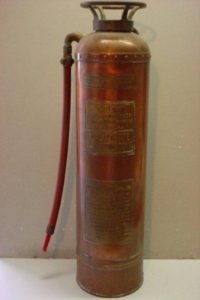
This extinguisher is useful for class Afire (wood, paper, fabrics, rubbish etc.) It should not be used on fires of electricity, oil, chemical or metal. It is available in both the shapes-cylindrical and conical.
Its normal capacity is 9 Ltr (weight 14 Kg) and to be used in a range of 6 to 8 meter. It consumes within 1 to 1.5 minute. It should be checked every 3 months.
It is held vertically up (not inverted). By standing 4 to 5 meter away from the fire, after opening the plunger it is struck on the hard surface. A small H2SO4 (Sulphuric acid) bottle breaks and due to its mixture with soda bicarbonate solution, CO2 (Carbon dioxide) is generated. Pressure of CO2 throws water at a distance. Its handle and bottom are held by two hands and water is sprayed on fire to extinguish it.
(2) Foam Portable Fire Extinguisher:
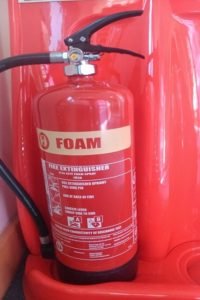
It is used on class B small fire. It should not be used on electrical or metal fire. It is available in 9 Ltr cylinder and used in 4 to 6 mt range. It consumes within 1.5 minute. It is available in wheel mounted trolley of 18 Ltr and 150 Ltr capacities for longer use. It should be checked every 3 months.
By standing 3 to 4 mtr away from the fire, the plunger is pulled up and turned right up to a slot. It is shacked by turning 180 degree twice. Then it is held inverted. By chemical reaction CO2 is generated which throws from outside. The foam is not thrown directly in fire but it is thrown on nearer hard surface so that because of striking further foam is generated and spared on burning surface. It stops oxygen availability for burning and controls the fire. Foam is effective up to 120 degree centigrade temperature only.
(3) Co2 (Compressed gas) Portable Fire Extinguisher:
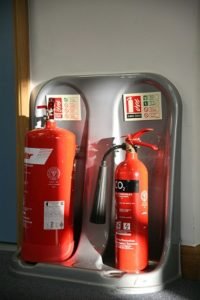
It is useful on class E i.e. electrical fire because Co2 is non-conductive gas. It can be used on class B and C fire also, as it diminishes oxygen to control fire. It is not advisable to use it in a closed room as more CO2 may be inhaled. Therefore open doors and windows before using it in a room. It should not be used on fires of metal, sodium, potassium and metal hydrides.
It is available in 2 kg, 4 kg, 6.8 kg and 22.5 kg capacities. Small cylinders have handles and big cylinders have wheels. Its range is 1 to 1.5 meter. CO2 pressure is at 64 to 70 bar. It should be checked every three months.
(4) Dry Chemical Power (DCP) Portable extinguisher:
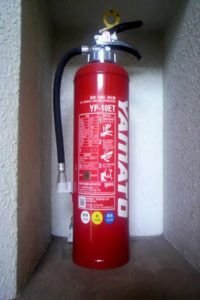
This can be used on any class of fire. Therefore it is known as ‘universal’ type extinguisher It is generally used on fire of flammable liquid. It is not effective on fire of benzene, ether, EO and CS2. For metal fire, special powder extinguishers are available 1, 2, 5 and 10 kg extinguishers in cylinders and 68 kg in wheel models are available.
A 10 kg portable fire extinguisher cylinder is consumed within 12 to 15 seconds and its range is 3 to 6 meter. A 68 kg cylinder is consumed within 1 to 1.5 minute and its range is 6 to 8 meter. Both should be checked at 3 months interval.
By standing 6 to 8 meter near the fire, the cylinder is shacked twice by turning 180 degree, a safety clip is removed and plunger is pressed or struck so that CO2 bottle breaks and it throws dry chemicals out. The dry powder blankets the burning surface, stops O2 contact and CO2 coming out also diminishes O2 proportion. Therefore fire is controlled by double action. Its long nozzle should be turned in wind direction like a broom.



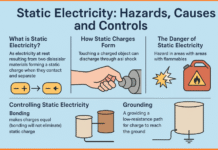
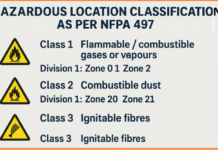

refer nbc
do you have any document which give the value of fire load density for light ,moderate and high hazrd catagor